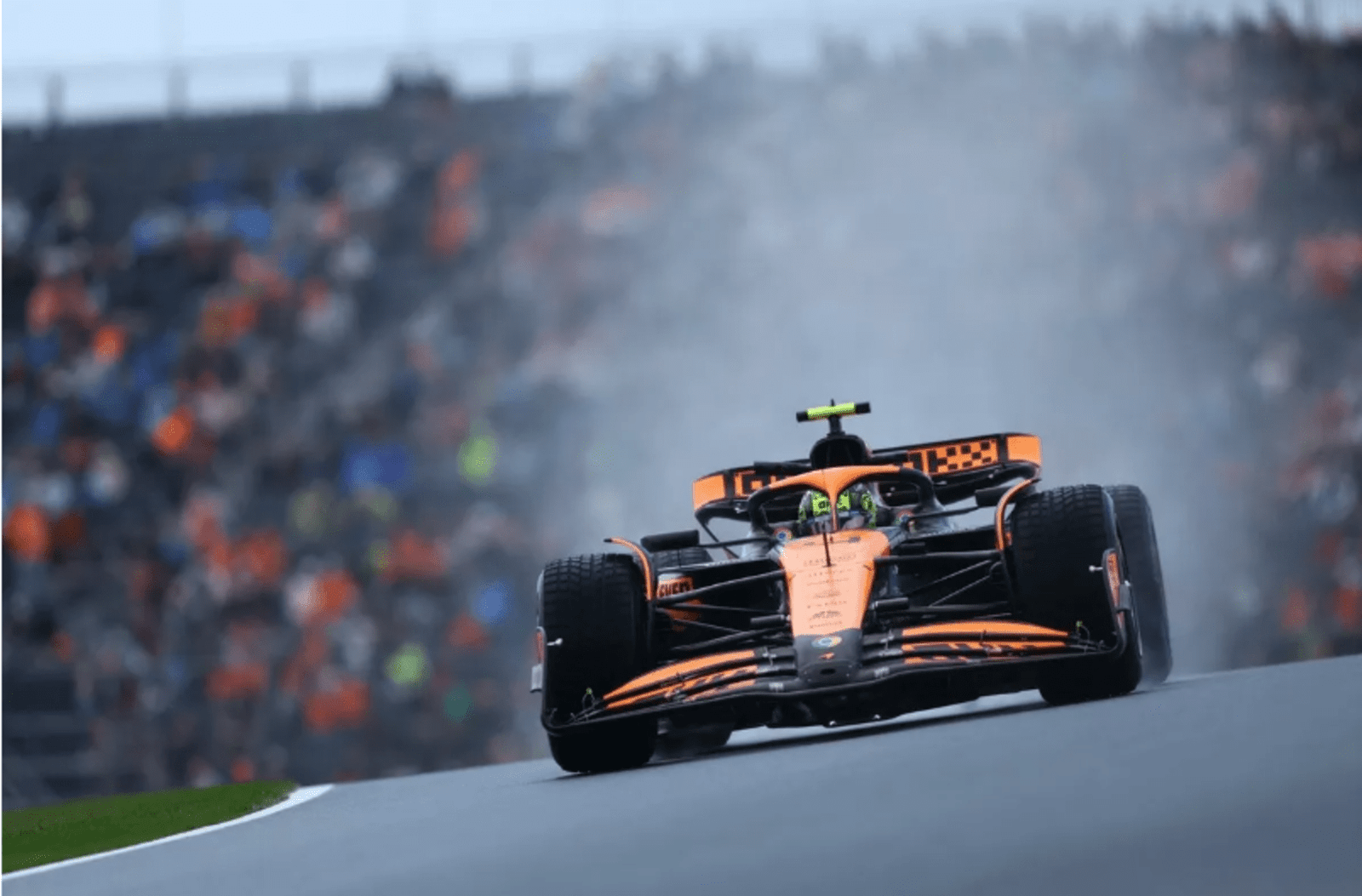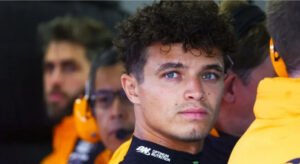
Norris Tops: Dutch GP Practice Amidst Wild Conditions
Opening Session Overview
The first practice session of the Dutch Grand Prix saw McLaren’s Lando Norris set the fastest time. The session kicked off with difficult conditions, including heavy rain and strong winds. As the hours went by, the skies cleared, and the track gradually dried. Despite the improved track surface, the gusty winds persisted throughout. Norris Tops: Dutch GP Practice.
Wind and Weather Challenges
The wind was fierce, gusting over 70 km/h throughout the session. This made driving tricky for all the drivers. The session began with wet conditions, causing initial difficulties. As the hour progressed, the track conditions improved, but the wind remained a constant factor.

Norris Leads the Way
Norris’s fastest lap was 0.201 seconds quicker than Verstappen’s. This performance was a key indicator of McLaren’s progress, highlighting the impact of their new upgrades.
Hamilton’s Performance
Mercedes’ Lewis Hamilton finished third in the session. Traffic on the track affected his performance. Despite this, Hamilton’s position showed promise for the rest of the weekend.
Sainz and Ferrari’s Strategy
Ferrari’s Carlos Sainz secured the fourth position. This difference in tire choice likely influenced the lap times and positions.
Russell and Albon in the Mix
Mercedes’ George Russell finished fifth. He was followed by Williams’ Alex Albon and McLaren’s Oscar Piastri. Russell’s and Albon’s performances were noteworthy, given the tough conditions. Piastri’s placement also highlighted McLaren’s competitive edge.
Driver Errors and Spins
The challenging conditions led to mistakes and spins. Verstappen, in particular, had a moment at the chicane towards the end of the lap. Despite some drivers running wide or spinning, there were no crashes during the session.
McLaren’s Upgrades
McLaren’s performance was encouraging. The team introduced their first performance upgrade since the Miami Grand Prix. While the expected lap-time improvement is not as dramatic as the Miami upgrades, it still represents progress for the team. The upgrades are a step towards closing the gap to Red Bull.
Red Bull’s Upgrades
Red Bull also brought updates to their car. The team aimed to regain their position as the fastest in F1. The upgrades are part of their strategy to maintain their lead in the championship.
Red Bull Racing’s upgrades for the Dutch Grand Prix are a key aspect of their strategy to reaffirm their dominance in Formula 1. With the team’s status as a front-runner in the championship, the introduction of these new components is crucial for maintaining their competitive edge.
The upgrades were designed to address specific areas of the car’s performance. Typically, Red Bull focuses on enhancing aerodynamic efficiency, improving downforce, and optimizing tire performance. For this race, the updates likely included changes to the car’s aerodynamic package, such as new wing designs and modifications to the floor and diffuser.
Track and Weather Conditions
The Zandvoort track, located in sand dunes along the North Sea coast, experienced unsettled conditions. The weather is expected to remain unpredictable throughout the day.
The track conditions at the Zandvoort circuit during the first practice session of the Dutch Grand Prix were notably challenging. The session proved challenging for drivers due to the interplay of strong winds and fluctuating track surfaces.
The session began with the track wet from recent rainfall. Early in the hour, drivers faced slippery conditions that made handling difficult. Rain-soaked surfaces demanded careful driving, with drivers needing to adjust their techniques to prevent skidding and maintain control. The initial stages were marked by several spins and errors as drivers adapted to the slick track.
As the session progressed, the weather started to change. However, the drying process was uneven, leaving some parts of the circuit still wet and others relatively dry. This inconsistency added another layer of difficulty for the drivers, who had to navigate areas with varying levels of grip.
In addition to the wet track, the weather was significantly affected by strong winds. Gusts reached speeds of over 70 km/h, creating additional challenges. The wind’s impact was felt throughout the session, as it influenced car stability and handling. Drivers had to contend with gusts that could push the car off line or affect braking and acceleration.
The combination of these factors made for a demanding practice session, testing the drivers’ skill and adaptability. The fluctuating conditions at Zandvoort highlighted the need for teams to continuously adjust their strategies and setups in response to the ever-changing environment.
Looking Ahead
As the weekend progresses, the weather and track conditions will continue to play a crucial role. Teams will need to adjust their strategies and setups to cope with the fluctuating conditions. Norris’s strong performance in the first practice session sets a positive tone for McLaren.
Hamilton, Sainz, and others will look to improve their times as they adapt to the changing track. The session provided a glimpse of the competitive nature of the Dutch Grand Prix. With more practice and qualifying sessions ahead, teams will aim to refine their setups and strategies.
Conclusion
The first practice session of the Dutch Grand Prix showcased the impact of weather and track conditions on performance. Lando Norris’s top position was a highlight, reflecting McLaren’s progress.
As the weekend unfolds, drivers and teams will continue to navigate the challenging conditions. The evolving weather at Zandvoort will keep the competition intense. With further practice and qualifying sessions, the stage is set for an exciting race.








